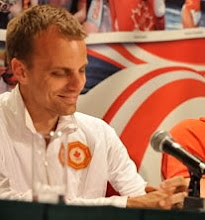There's been a bit of a controversy brewing around Olympic figure skating — surprise, surprise. This time, the story is the exclusion of Japanese prodigy Mao Asada. Asada has been one of the best skaters in the world this year, winning gold at the Grand Prix final. Unfortunately for the Japanese, Asada is just barely 15 years old — old enough for senior international competitions like the Grand Prix, but too young to compete in the Olympics.
The IOC, I should point out, is not making the rules here; the athlete eligibility criteria are set by the IFs. Figure skating has a minimum age limit only because the ISU sets one. Despite the fact that one of the world's best figure skaters will be unable to compete at the Olympics, ISU officials have stated that there will be no exception, and no rule change, which is as it should be. To modify the rules at this late date, or to make an exception for a single athlete, would be unfair to everybody. But what is this rule all about in the first place?
The age limit is ostensibly for the protection of the athletes, but as this editorial by Philip Hersh points out, it isn't clear that the ISU has thought this through:
"This is a rule based on medical aspects and not a technical one," [ISU President Ottavio] Cinquanta said.
The idea behind that statement is laudable. Rushing young skaters to senior championship competition, with its multiple triple jumps, is dangerous at ages when growth plates have not fused. Young bodies are subject to even more pressure under the new judging system, which rewards programs jammed with technical demands and jumps late in the program.
Yet skaters already are doing the same demanding technical elements, especially jumps, to compete on the senior Grand Prix level and, in many cases, to compete at the junior level. This is especially true of prepubescent girls, whose hipless, small-chested bodies often have the perfect strength-weight ratio to pull off jump after jump.
The risk of long-term physical damage from such repetitive pounding is well documented. Less evident is how that can be compounded physically and mentally when skaters face the frustration of trying to keep doing those jumps with the changed center of gravity and proportions of a woman's body.
If the ISU really were concerned about skaters' health, it would severely limit the number of triple jumps women (and, to a lesser extent, men) can do in competition, especially before they reach the senior level.
Asada did 11 jumps — six triples, including the difficult triple axel, and five doubles, four in combinations after triples — in her free skate at the Grand Prix Final. To get extra credit, she did seven of the jumps in the second half of the four-minute program, when fatigue makes the body more susceptible to injury. It is plainly absurd to say Asada is old enough to do that in December but not in February …
I don't have a lot to add. It may be a good thing to prevent young athletes from doing lots of jumps, but this rule doesn't seem to accomplish that goal.
And as long as we're on the topic of eligibility rules and IFs, here's some soccer news that's a few weeks old; FIFA is planning to eliminate the loophole that allows men's football teams to bring three over-age players to the Olympics. The men's football competition at the Olympic Games will become strictly an under-23 tournament. In this case, FIFA is protecting the health of its brand rather than the health of its athletes; they are only interested in the supremacy of the World Cup, and won't let the world's best play anywhere else.


